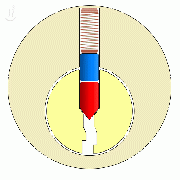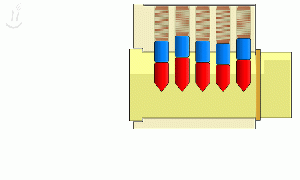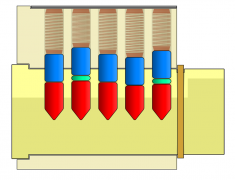Keys
Keyholders
The purpose of this document is to outline the process and criteria we will use to decide who will be granted the use of a key to the front door of the Omni Commons. The criteria and process seek to balance the security and safety of both the people who use the Omni Commons and the building itself, and the need for access.
Front Door Key Access Process and Criteria
- People will be eligible for a key if:
- They are a member of a member collective who has been identified by that collective as someone who needs a key. Each collective will make that decision by their own process to determine who is entitled to reasonable access and able to assume the responsibilities that come with being an Omni key holder.
- Some factors to consider are:
- Does the member need to open or close up the building?
- Does the member take responsibility for collective activities and events?
- Does the member participate in organizing the Omni or maintaining the building?
- Is the member someone who understands their responsibility to take care of the Omni and the people inside it, and who is trusted by the collective?
- The collective will enter the name and contact information for the member who will be given a key in the (contact manager spreadsheet)
- Some factors to consider are:
- As an unaffiliated Omni volunteer, they ask for a key using this form (see below).
- (Which working group? A new Keymaster WG?) will review key requests and approve or deny them.
- They are a member of a member collective who has been identified by that collective as someone who needs a key. Each collective will make that decision by their own process to determine who is entitled to reasonable access and able to assume the responsibilities that come with being an Omni key holder.
- All key holders will be required to give a key deposit of $5 which will be used to replace lost keys. Upon turning over their key to the (working group), the deposit will be returned.
- Keys will be given along with a document that states the benefits and responsibilities of being a key holder and how to close up the building. Not fulfilling the responsibilities may be grounds for having to return the key.
Key Request Form
Note: we have an online version of this form here
- Date
- ____________________
- Name
- ____________________
- Please provide preferred mode of contact and contact information:
- ___________________________________________________________________________
- I am an active member of an Omni Commons Working Group (Y or N):
- ___________________________________________________________________________
- If yes, which working group(s):
- ___________________________________________________________________________
- I need a key because:
- ___________________________________________________________________________
- This Omni Keyholder is my reference:
- ___________________________________________________________________________
Omni Key Holder Responsibilities
A person who has been granted a key to the front door of the Omni Commons should understand the responsibilities that come with the key.
With a key you have the ability to enter the Omni at any time. For this benefit you are one of the people responsible to help keep the Omni building and the people in it safe and secure.
Be familiar with the Omni rules for behavior, and the safer space policy.
Keep the exterior doors closed when La Commune is closed (including 48th St) unless there is a known, responsible person familiar with Omni policies (preferably yourself) paying attention to who is entering. This is particularly important early in the morning and late at night. People holding events in the evening are responsible for having someone posted at the doors to direct people to their event and prevent people from on the sidewalk behaving in ways that would annoy the neighbors.
When there are no events happening, everyone in the building who is not a member of an Omni member collective must be the guest of a member. If someone is not a guest, you should tell them the Omni is closed and ask them to leave if you are not willing to have them as your guest.
If you are leaving in late at night, check to make sure that there are only members and their guests in the building. Let them know you are leaving and make aure that at least one person remaining is willing, and knows how, to close the building when they leave.
How to Close the Omni
What you need to accomplish before leaving the Omni:
- Make sure everyone is gone.
- Make sure there are no hazardous or other conditions that shouldn’t be left overnight.
- Make sure the 48th Street and Shattuck Ave ballroom doors are closed and locked. There are 2 doors to 48th Street. One is at the end of the hallway that goes past the trash room. To reach the other one, walk to the door at the far side of the disco room. The door opens onto stairs that go down to a door.
- Turn off ballroom fans and all the lights except emergency lights.
- Make sure the front door on the corner of 49th an Shattuck is locked behind you when you leave.
It is preferable to have at least 2 people to check the building at the end of the night. Walk through the entire building together to look for any of the above situations. This includes all the bathrooms, the ballroom mezzanine, all rooms in the basement, etc.
Ask any people you find to leave because the building is closing. Usually they will, although they may grumble and move slowly. Do not raise your voice or touch them. If you find someone who is threatening or who refuses to leave, call one of the people on the emergency contact list to help you.
Where are the switches?
Most of the chandeliers in the ballroom are controlled by dimmers on the wall above the left side of the bar as you are facing it from the ballroom (the N side of the bar). The one above the mezzanine is on a dimmer in the mezzanine room on the E side of the ballroom. As you are in the room looking out over the ballroom, the round dimmer is above the electrical panel.
The switch for the ceiling fans ceiling fans is located in the electrical panel in the ballroom mezzanine room. The switch is at the lower left side the panel and is labelled “FANS”. There are also override switches for the chandeliers in that area.
Locks
There are many different kinds of locks. Most of the locks that you'll play with on a day-to-day basis are pin tumbler locks, primarily of two brand names:
The inside of a typical pin tumbler lock, the first animation below shows how the pins are set to enable the cylinder to turn and release the latch/deadbolt.
Mastering
You can also set pins on top of one another so that multiple keys can successfully turn the cylinder, using a "master" key and a "change" key. The idea is that several cylinders will be keyed to the "master" and each cylinder will also be keyed to its own unique "change" key.
Educational Resources
- Cylinder Locks on Wikipedia
- Lockpicking slides and links by TOOOL (The Open Organisation of Lockpickers)
Law
- In California, it is lawful to duplicate existent keys. Further, a "Locksmith" is defined as a person who engages "in the business of rekeying..." etc, "for any consideration or compensation whatsoever" ('consideration' meaning benefit of a contract i.e. not a gift).
- Locksmith Act (index) of the Business and Professions Code.
- SECTION 6980 of the Business and Professions Code:
(j) "Locksmith" means any person who, for any consideration or compensation whatsoever, engages, directly or indirectly and as a primary or secondary object, in the business of rekeying, installing, repairing, opening, modifying locks, or who originates keys for locks, including, but not limited to, electronic cloning of transponder keys and any other electronic programming of automotive keys and electronic operating devices, such as key fobs, door and ignition key devices, and successive electronic and other high-security key technology. A "locksmith" does not mean a person whose activities are limited to making a duplicate key from an existing key.
- In California, there are explicit exemptions for activities that would normally require a locksmith license:
- Section 6980.12 of the Business and Professions Code:
6980.12. This chapter does not apply to the following persons: (a) A person, or his or her agent or employee, who is the manufacturer of a product, other than locks and keys, and who installs, repairs, opens, or modifies locks or who makes keys for the locks of that product as a normal incident to its marketing. (b) An employee who is an industrial or institutional locksmith, provided that the employee provides locksmith services only to a single employer that does not provide locksmith services for hire to the public for any consideration or compensation whatsoever. (c) A tow truck driver who does not originate keys for locks and whose locksmith services are limited to opening motor vehicles. (d) A person employed exclusively and regularly by a state correctional institution, or other state or federal agency, and who does not provide locksmith services for hire to the public for any consideration or compensation whatsoever. (e) (1) A person registered with the bureau pursuant to Chapter 11 (commencing with Section 7500) if the duties of that person's position that constitute locksmithing are ancillary to the primary duties and functions of that person's position. (2) A person licensed, certified, or registered pursuant to Chapter 11.6 (commencing with Section 7590) if the duties of that person's position that constitute locksmithing are performed in combination with the installation, maintenance, moving, repairing, replacing, servicing, or reconfiguration of an alarm system, as defined in subdivision (n) of Section 7590.1, and limited to work on electronic locks or access control devices that are controlled by an alarm system control device, including the removal of existing hardware. (f) An agent or employee of a retail establishment that has a primary business other than providing locksmith services, providing all of the following criteria are met: (1) The services provided by the retail establishment are limited to rekeying and recombination of locks. (2) All rekeying, recombination, and installation of locks must take place on the premises of the retail establishment. (3) All rekeying, recombination, and installation services provided by the retail establishment subject to this chapter are limited to locks purchased on the retail establishment's premises and are conducted prior to purchasers taking possession of the locks. (4) An unlicensed agent or employee of the retail establishment shall not advertise or represent himself or herself to be licensed under this chapter, and an agent or employee of the retail establishment shall not advertise or represent himself or herself to be a locksmith. (5) An agent or employee of the retail establishment shall not design or implement a master key system, as defined in subdivision (o) of Section 6980. (6) An agent or employee of the retail establishment shall not rekey, change the combination of, alter, or install any automotive locks. (7) The retail establishment shall not have on its premises any locksmith tool, as defined in subdivision (s) of Section 6980, other than the following: (A) Standard key duplication machines. (B) Key blanks. (C) Pin kits. (g) A law enforcement officer employed by any city, county, city and county, state, or federal law enforcement agency, if all services are performed during the course of the officer's professional duties. (h) A firefighter or emergency medical person employed by any city, county, city and county, district, or state agency, if all services are performed during the course of duties as a firefighter or emergency medical person. (i) A new motor vehicle dealer, as defined in Section 426 of the Vehicle Code, and an employee of a new motor vehicle dealer acting within the scope of employment at a dealership.
- In California, it is lawful to possess lock picks (i.e. circumvention tools) by statue, the state must prove criminal intent.
- Burglarious And Larcenous Instruments And Deadly Weapons Section 466-469 of the California Penal Code
§ 466. Every person having upon him or her in his or her possession a picklock, crow, keybit, crowbar, screwdriver, vise grip pliers, water-pump pliers, slidehammer, slim jim, tension bar, lock pick gun, tubular lock pick, bump key, floor-safe door puller, master key, ceramic or porcelain spark plug chips or pieces, or other instrument or tool with intent feloniously to break or enter into any building, railroad car, aircraft, or vessel, trailer coach, or vehicle as defined in the Vehicle Code, or who shall knowingly make or alter, or shall attempt to make or alter, any key or other instrument named above so that the same will fit or open the lock of a building, railroad car, aircraft, vessel, trailer coach, or vehicle as defined in the Vehicle Code, without being requested to do so by some person having the right to open the same, or who shall make, alter, or repair any instrument or thing, knowing or having reason to believe that it is intended to be used in committing a misdemeanor or felony, is guilty of a misdemeanor. Any of the structures mentioned in Section 459 shall be deemed to be a building within the meaning of this section. § 466.3. (a) Whoever possesses a key, tool, instrument, explosive, or device, or a drawing, print, or mold of a key, tool, instrument, explosive, or device, designed to open, break into, tamper with, or damage a coin-operated machine as defined in subdivision (b), with intent to commit a theft from such machine, is punishable by imprisonment in the county jail for not more than one year, or by fine of not more than one thousand dollars ($1,000), or by both.


